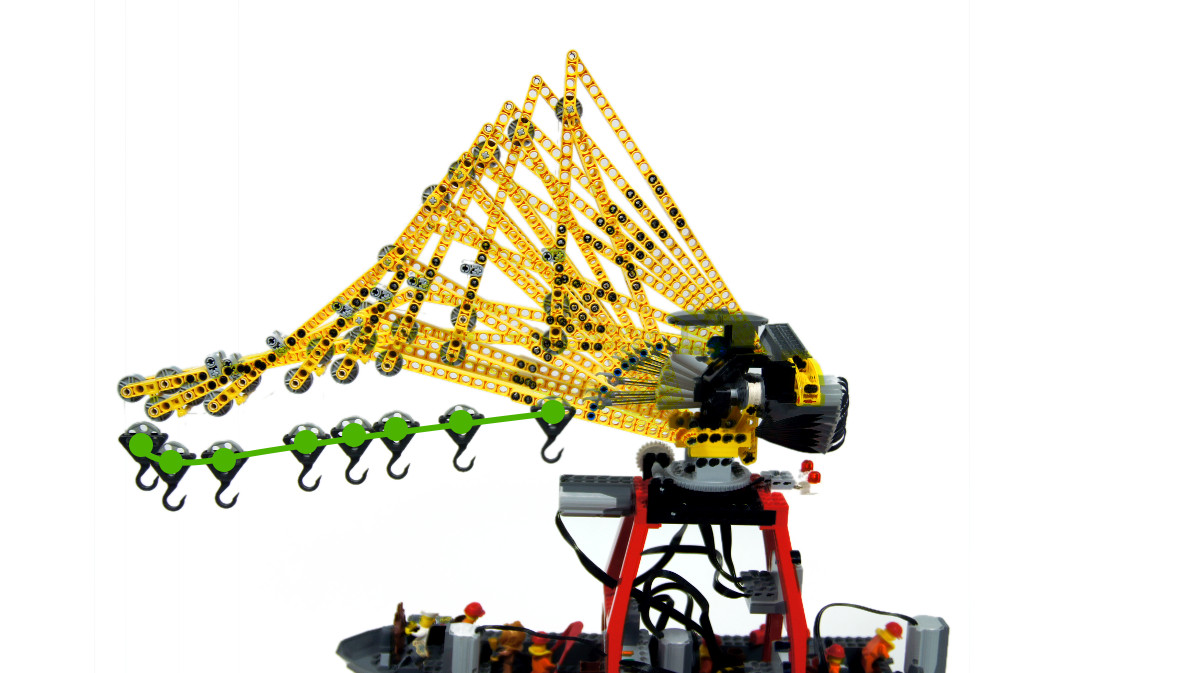Floating Crane
Model of a “horse head” crane installed on a multi-hulled boat. Features propulsion system with thrusters.
Datasheet:
Completion date: 11/04/2013
Power: electric (AAA battery box)
Dimensions: length 54 studs / width 28 studs / height 62 studs (including propellers, with raised boom)
Weight: 1.32 kg
Displacement: 1.8 kg
Suspension: none
Propulsion: 1 x PF Medium motor geared 1:1.6
Motors: 6 x PF Medium
I was looking for an opportunity to do some underwater filming, to test a boat with thrusters and to play with a “horse head” crane. This single creation includes it all.
Odd as they may seem, the floating cranes are quite widespread and have been known since Medieval Age. They have a variety of uses, from handling cargo and building ships or bridges, to functioning as rescue/recovery vessels by lifting sunken objects. I have based my design on two hulls connected closely side by side, with a typical harbor crane installed on top.
Since the vessel was intended for working in a bathtub, its speed was much less important than its manoeuvrability and locating the parts of the propulsion system between the hulls, where they can’t collide with bathtub’s sides. The basic propulsion was provided by a double propeller located between the hulls, driven by a single PF Medium motor with a small acceleration. This was further aided by two transverse thrusters – a bow and stern one – driven by a separate PF Medium motor each. Being able to work independently, the thrusters could rotate the vessel or propel it sideways. Combined with the main propeller, this provided a simple, reliable propulsion system that could move the crane in any direction without using rudders. It should be noted that the bow thruster proved less efficient than the stern one.
The crane could rotate through 360 degrees and had a boom built in a “horse head” set-up, also known as a level-luffing crane. The purpose of such a design is to move the load forward and backward along approximately straight, horizontal line. I kept the design as basic and lightweight as possible to keep the vessel’s center of gravity low, but it worked properly, with all the performance of larger and more complex harbor cranes (for instance, they usually include a moving counterweight). The crane’s top load capacity was not tested, but as the video below shows, when lifting a 150 grams heavy object on extended arm, the hulls are close to sinking on the loaded end. Thus the stability of the hulls was the limit of the whole vessel’s lifting abilities.
All in all, this creation was an experiment in several aspects, and it was a successful one. It worked as intended, it was fun to play with, and it avoided any accidents despite being somewhat risky.




























@big fun
Propeller: http://www.bricklink.com/catalogItem.asp?P=6041
Hull: http://www.bricklink.com/catalogItem.asp?P=54100c01
Is there a part number for the thrusters you used? and maybe one for the hulls as well?
@andrea
Come on, you can build everything from photos. All mechanics is exposed to see, all workings are explained in the text.
Very good job sariel! Any chance to have some building instructions to reproduce? My kids are really crazy for it 😉
Yes.
Did you use a GoPro Hero 3 for the underwater footage?
@Sander
Not really. While hamsters can in fact swim very well, they deeply resent water.
Ah… lego motors in the bath tub. The memories I have of this, still hunt me in my dreams… 8 years old and so happy with my 9V engine, untill the speed boat sank. I took me twenty years to throw the motor away, as it did not work since the bath-tub-drama. So, a brave venture Paul. No aquatic hamsters ? 😉
Looks great! Not sure if I agree with your comment about the stability of the hulls being the limit to the lifting capacity. The moving counter weight that full size sea cranes have is used to counter act the “tipping” of the loaded weight to make the boat remain level. Pretty difficult feature to include on a scale model though 🙂
@Sariel
Yeah, that’s what I thought you did. I’ve never seen that kind of propulsion system in any ship before.
@JC
Not really, I just learned how thrusters work and I went from there, figuring how to use them on my own.
Awesome piece of work! When you say you designed for “maneuverability over speed,” were there any kind of sea-boats/ships you had in mind for this unique thruster system you used?
good job sariel!